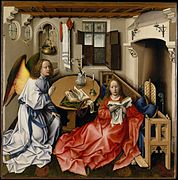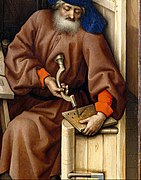Mérode triptych
The Mérode triptych is a painting attributed to an artist with the emergency name Meister von Mérode or Meister von Flémalle , who is associated with the workshop of Robert Campin from Tournai . Whether the unknown master is to be equated with Campin is controversial in art history. The picture, created between 1427 and 1432, is considered one of the artist's masterpieces. It is painted with oil on wood. The middle part is 64.1 × 63.2 cm in size. The wings are 64.5 × 27.2 or 27.8 cm in size. The picture is in the Metropolitan Museum of Art (more precisely: The Cloisters ) in New York .
history
At the beginning of the 20th century, the triptych was in the family chapel of the Belgian Counts de Merode in Westerlo . After the First World War it was kept in the safe of a Swiss bank. Even before the Second World War, the Belgian government tried several times to buy it, but Countess Jeanne de Merode bequeathed the painting to her niece Jeanne-Marie de Grunne in 1944. The count family de Grunne sold it to the Metropolitan Museum of Art in 1958 for one million dollars (at that time the equivalent of 4.2 million German marks - a very large sum even for top works of Flemish painting), which was followed by a wave of national outrage in Belgium.
Motif
The preaching of the Archangel Gabriel to Mary is depicted on the central panel . The donor of the picture with his wife, Peter Engelbrecht and Gretchen (Margarete) Schrinmechers, are shown on the left wing. Peter Engelbrecht was in 1400 as Petr. Ynghelbrecht de Machelinia, m. art. Col. matriculated at the University of Cologne . His place of origin Machelinia is Mechelen , where he later lived.
The central representation of the Annunciation is not a coincidence, but rather alludes to the name of the founder Engelbrecht, i.e. Der Engel brought to it. On the right wing you can see Joseph building mousetraps . Josef as a carpenter and not as a carpenter is explained by the comparison with the name of the founder's wife: Schrinmechers, an ancient form for carpenters. The mousetrap finds its meaning in the task of Joseph as "alibi husband" of Maria. He deceives the devil about the coming of Jesus as Savior. The origin of this lies in the saying of Augustine that Jesus is the mousetrap for the devil. However, this task is transferred to Joseph here.
Details
literature
- Jozef De Coo: A medieval look at the Merode Annunciation. In: Journal for Art History . Volume 44, 1981, pp. 114-132, doi: 10.2307 / 1482081 , JSTOR 1482081 .
- Norbert Schneider : Painting of the early modern period. From Masaccio to Delacroix. Interpretations of central works. Berlin / Münster: Lit 2017 (Karlsruher Schriften zur Kunstgeschichte, Vol. 11) pp. 26–29 ( books.google.de )
- Felix Thürlemann : Robert Campin - the Mérode triptych. A wedding picture for Peter Engelbrecht and Gretchen Schrinmechers from Cologne. Fischer, Frankfurt am Main 1997, ISBN 3-596-12418-2 .
Web links
Footnotes
- ^ Felix Thürlemann: The connoisseurship in the crisis. In: Neue Zürcher Zeitung. February 14, 2009 ( nzz.ch ).
- ↑ Altarpiece - Not for sale . In: Der Spiegel . No. 8 , 1958, pp. 53-54 ( Online - Feb. 19, 1958 ).
- ^ The register of the University of Cologne. P. 564 ( Textarchiv - Internet Archive ). Nicolaus Ynghelbrecht, from Mechelen (Diocese of Cambrai), dives, matriculated in Cologne in 1398: Nic. Johannis Engelberti de Mechlinia, cl.Cam. d .; art. ( Die Matrikel der Universität Köln. P. 76, Textarchiv - Internet Archive ), 1401 presented by King Ruprecht to the S. Peterskirche in Besa (Diocese Cambrai) on a canonical and a preamble (Christoph Fuchs: Dives, pauper, nobilis, magister, frater, clericus. p. 379, books.google.de ).
- ↑ Meyer Schapiro: "Muscipula Diaboli": The Symbolism of the Merode Altarpiece. In: Art Bulletin. 27, 1945, pp. 182-187.







